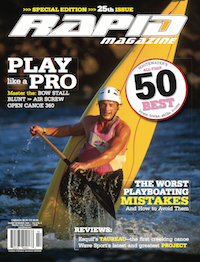By the time we got back to the highway it was dark and our drysuits were covered in dust. We’d taken out at dusk after a great run of the Opeongo River and discovered that Pablo had left his keys— the take-out keys—in the pocket of his cords on the front seat of the put-in truck. Twenty-four kilometres we hoofed it in soggy river shoes with no water and no food.
Goofy things like this happen to us all but they happen more often when you’re new to paddling. Whitewater is full of little tricks and secrets that if you stick around long enough you eventually figure out, usually the hard way.
I sit on the board of directors of the Trade Association of Paddlesports, a group that talks a lot about how to maintain growth in our sport. There is no shortage of people lining up to try whitewater. Paddling schools across the country are busy. The issue is attrition—turning students into paddlers.
As an instructor I seldom bump into my students on the river. Why not? They leave with a decent forward stroke, a roll and the skills to hit eddies. Walking out to the highway, Pablo and I had six hours to think about why there were no other paddlers around to give us a ride. We figured maybe we aren’t teaching the right things.
We need to remember that whitewater paddling is about rivers. Every student in every class should go down a river. Ideally a pretty one. For sure an easy one. Nobody dreams of learning the forward stroke. Wannabe paddlers dream of great adventures and shooting rapids, and we are squashing that spirit with stroke drills. There’s plenty of time for technique later; for now they need to learn to love the game.
You know why else it’s good to take them down a river? Because then they’ll know one. They’ll know how to scout, run safety, and shuttle. They can rent boats and gear and paddle that river all summer long, every weekend if they want.
We need to teach students to tie their own boats to a roof rack or trailer. we should go to a scrap yard with a cutting torch and lift the roof off a mini van, mount a set of Yakimas on it and have students practice loading boats and tying trucker’s hitches until they are sure they won’t be fishing boats out of a ditch. It’s pretty tough to go paddling if you can’t get your boat to the river, and nothing says newbie like asking retail staff to tie your boat on for you.
We need to give new paddlers the straight take about boats and gear. Not as salesmen, but as instructors, paddlers and friends. New paddlers need to know that they were using institutional gear and there is better gear that is more comfortable and warmer, and that nobody writes their name across the front of their helmet on duct tape.
As instructors we get two days with our students. It’s not enough time to master any stroke or move. So instead of teaching our students to paddle perfectly, we should teach them to be paddlers. Once they are hooked we’ll get them back. Then we’ll work on their strokes and bombproof their rolls. And if we can get rookie paddlers to stick with it, there will be more people to help when guys like us, who should know better, pull a rookie move.




